https://aimeemelaughart.wixsite.com/artist
http://www.aimeemelaughart.com
AIMEE MELAUGH
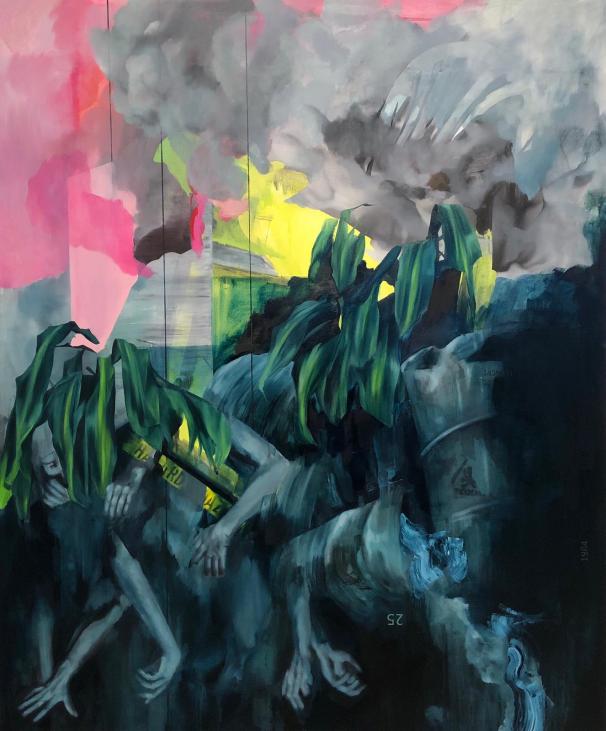
I do not need to know the data, the exact time and place. The arms and hands are those who work with them and who are undernourished. They come to the foreground through green wilting vegetation. The blue tonality replaces the normal skin tone. The yellow and pink explode above the people’s heads in front of smoky grey tones. The diagonal composition divides the cause from its impact as an indication of the sequence that caused the demise of life.
In her notes, Melaugh refers to “theory of affect” by Baruch Spinoza. I do not know that passage. In relation to his statements in The Ethics, I sense that it may be near to his thinking about “mode”.
“ID5: By mode, I understand the affections of a substance or that which is in another through which it is also conceived. A mode is what exists in another and is conceived through another. Specifically, it exists as a modification or an affection of a substance and cannot be conceived apart from it. In contrast to substances, modes are ontologically and conceptually dependent.” (Book One, Ethics accessed on https://www.iep.utm.edu/spinoza/)
Spinoza makes it central to his theory of knowledge that to know a thing adequately is to know it in its necessity, as it has been fully determined by its causes. In the Bhopal painting, the need to work and the need to use volatile materials are present in the careful identification of hands and industrial barrels, both ontologically necessary and sufficient. The descriptive mode ends in the diagonal of wilted plants with a partly hidden warning that reads “hazard” on the yellow ground. The surrealist element of hands growing out of one barrel and of deadly vapours escaping from another indicate the connection to the explosion rendered in buoyant energy of wilful abstraction.
Both painterly modes are cherished for their singularity and conceptual dependency on the subject. No doubt where the meaning has its cause.
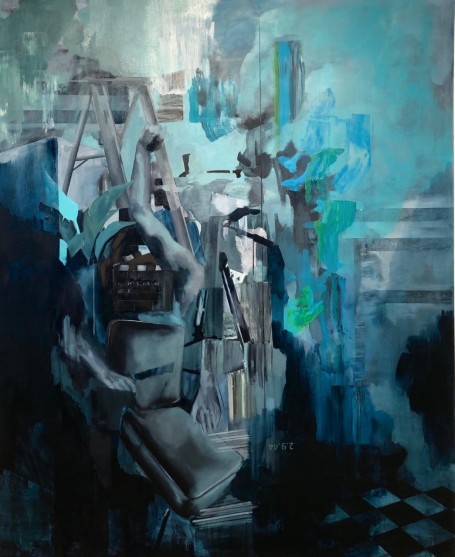
The decision to evaporate the figure and not the three hands as if still engaged in some normal activity is an image unimaginable outside some disaster. The collapse is not yet complete, the perfect seat for no one to sit on screams visual ” j’accuse”. It does not address a particular perpetrator thus making its reason somewhat commonplace for humanity. The price? Everything else disintegrates, evaporates, changes its substance. Apocalypse now?
The paintings on a smaller scale invite methods of surrealism and of the informel to forge strong compositions capable of holding together accidental occurrences of negligence. And of different time and speed.
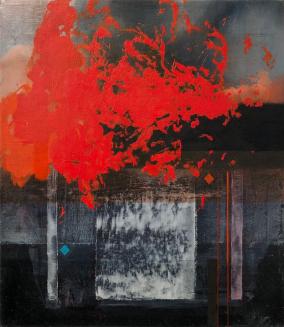
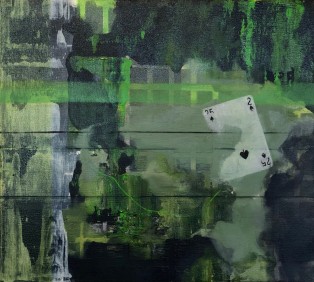
Green is slower than the red.
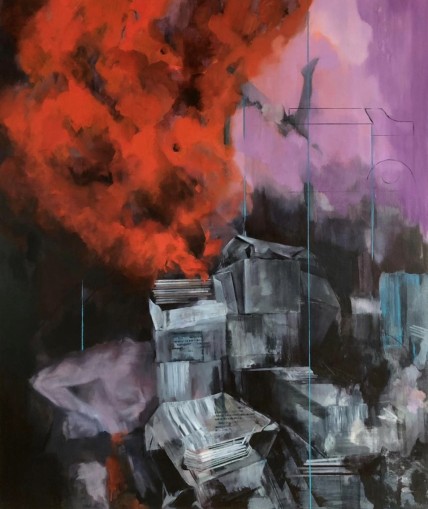
In reference to her grandfather experience during the WW2 this painting exchanges the human fragility for the destruction of the seats for the gunners. See-through seats are reminiscent of sheets of papers on which the various decrees, calls to arm, and agreements may have been written. While the (still) living naked male appears both safe (the modulation of the muscles) and evaporating (the ever-receding tonality turns his volume into a ghostly plane). The female leg shooting out of some roofs on the horizon – could be just a wooden model for selling stockings. Or not. Seats and houses are crumbling. And so is the control of our destiny in any war. The case for peace is ever present.
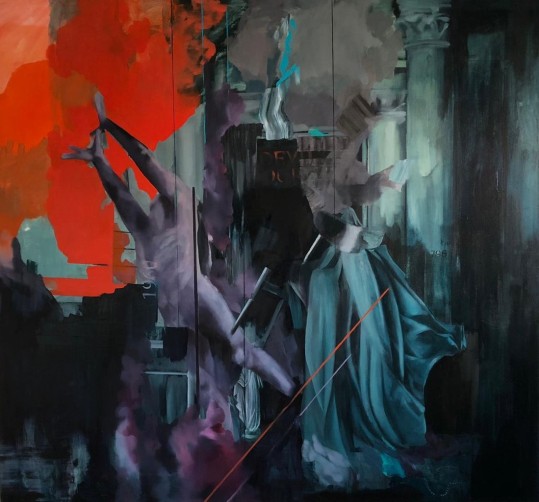
Icarus? A sexless nude body as if calling in distress moves away from a tiny religious sculpture detailed in the lower region. That headless statuette is silent and as if protected from the troublesome accusation by the purple body. The tone is ordered to be between life and death forever… akin to the belief in Purgatory? Or eternal life in hell? The red ground above could suggest that precipice. A pale variant of the gesture appears on the right-hand side, in front of the two columns lit up by the light from outside. Behind it something like a bookshelf, volumes of documents? A revelatory moment?
The right-hand side of the Tuam describes some earthly conditions: the power of the architectural order preferred in churches, thus power of the church. And the flowing habit invites association with nunnery. Or with actual evidence:
7 Mar 2017 – The Tuam mother and baby home, where human remains have been discovered, was “a chamber of horrors”, the Irish PM has said. (https://www.bbc.co.uk/news/world-europe-39192744)
7 Jun 2014 – Catherine Corless’s research revealed that 796 children died at St Mary’s. …
The painting – mute and timeless- accesses our innermost conscious responses directly, not subject to logic or grammar or correctness. Perhaps that is what Melaugh had in mind when she recalled Spinoza.
Images courtesy the artist.